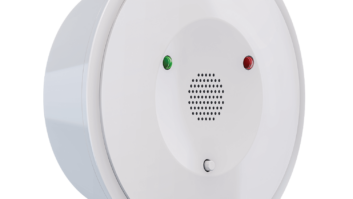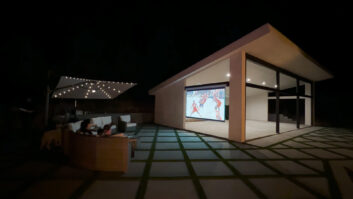Solving Long-Distance HDMI Runs with Cat-6 Twisted Pair Solutions

Now that digital HDMI connections finally are supplanting legacy component video and analog audio infrastructures, many integrators are wrestling with what it takes to run HDMI over longer distances, reliably. It is essential to understand the underlying technologies and protocols and to develop the appropriate purchasing criteria and best practices for designing, implementing, and supporting this new digital infrastructure.
Two Ways to Extend HDMI
There basically are two main approaches to extending an HDMI signal over longer distances. One is to integrate an HDMI matrix switcher as the core of the distribution system (which is another challenge in and of itself) and then use whatever products that vendor offers as part of its integrated solution. The other approach is to install an HDMI extender infrastructure, independent of the specific switching and signal routing devices.
The most common approach to extending HDMI is to use a pair of Cat-6 twisted pair cables (although some still use Cat-5) between the HDMI sources (transmitters) and the HDMI sinks (receivers). However, it is important to note that other solutions are available, too. These include both fiber for longer distances and coax when retrofitting the cables from a component video distribution system. There are some potential opportunities for wireless, as well. In this article, we will focus on twisted pair solutions, although the principles also are applicable to these other technologies.
What Are We Trying to Extend?
It is important to note that the HDMI specification does not stipulate maximum cable lengths. It is all about performance–the ability to deliver the signal reliably and without degradation from end to end. What does that really mean from an engineering standpoint?
There are three different “components” to the HDMI signal. All three have to be distributed properly or the end result may end up being a troubleshooting nightmare.

The NextGen Single Cat-6 to HDMI Splitter extends and distributes high-resolution video signals over a single Cat-6.
1 Video. The video component consists of three (red, blue, and green) transition minimized differential signal (TMDS) shielded twisted pairs, plus another clock pair for synchronizing the signals from one end of the link to the other. The audio also is multiplexed with the picture on these TMDS lines. Performance for this aspect of the connection is about being able to deliver a flat 340 MHz of “bandwidth” from one end to the other. This equates to an aggregate digital transfer rate of 10.2 Gbps across all four TMDS lines. This is the minimum required digital transfer rate for both HDMI 1.3 and HDMI 1.4a; HDMI 1.4 maxes out at the same 10.2 Gb/s.
Delivering these TMDS signals reliably depends upon the same electrical characteristics of the cables (impedance, resistance, capacitance, and inductance) that any high-frequency analog or digital cabling medium encounters. Being out of spec on any or all of these drastically impacts the ability to deliver a pristine picture. Connections with marginal tolerances or characteristics that are close to the edge further complicate the picture.
2 Digital Handshaking. The most familiar digital handshaking terms are Hot Plug Detect (HPD), the Consumer Electronics Control (CEC) line, and the Display Data Channel (DDC), which includes the infamous High-bandwidth Digital Content Protection (HDCP) handshaking. Performance for these is all about delivering high-speed five-volt digital logic transition levels, which are susceptible to the same electrical characteristics of the interconnecting wires. With faulty or marginal TMDS lines, the picture may experience “digital glitches,” but the image still gets through. With digital handshaking lines, the result is binary. The link either works, or it doesn’t. One of the primary causes of HDMI connection failures is DDC corruption.
3 Five-Volt Power. This is yet another area that can cause problems in poorly designed HDMI Extenders. The sole purpose of the HDMI five-volt line is to power the electronics on the sink (receiver) side of the connection. Think of when the TV is not on. The HDMI interface still needs to be active for the initial HDMI handshaking to work (HPD, etc.). This integral five-volt line, per specification, does not need to deliver more than 1 mA of current. This is just about enough juice to drive the receiver’s HDMI chip set. It never should be used to drive any active electronics for the HDMI Extender itself. Additionally, this line must remain above 4.7 volts DC. Extended cable lengths impact how much voltage drop takes place.
HDMI Extender Standards
Here are three factors to keep in mind when evaluating a vendor’s implementations for extending HDMI over longer distances:
1 Look at what type of pull-up resistors are used on the digital logic lines. Good Extender designs drive the DDC lines up to about 10 mA using 470 ohm resistors instead of the normal 4.7 K used when only delivering the minimum 1 mA of current. Then they use clamping gates at the receiver end to drop the DDC levels back to the HDMI specification. This helps eliminate DDC corruption due to the electrical characteristics of the cable.

Spectrum Electronic Solutions offers an HDMI Switch series that includes the DSW 731 and DSW 751 with either three or five inputs and one output on each.
2 Look for automatic equalization (EQ) circuitry that keeps the “digital logic” rise times under 260 ns no matter what length of wire is used. This allows for varying digital logic transition rates based on different cable lengths. Poorer implementations without EQ may extend this time to about 1000 ns, which kill the handshaking signals.
3 See if they incorporate status LEDs as a diagnostic aid for when you first bring up the HDMI extender. They usually will have a power indicator and a Hot Plug Detect Valid LED in the transmitter, which provides a status of the overall voltage and initial handshaking.
Most extenders also have three LEDs in the receiver for providing an indication of the “health” of the line.
■ Power Supply – Green
■ Data – Yellow
■ Clock – Blue
The data and clock LEDs will flash during the initial connection. They will stop and then start again in about two seconds, providing a “wiggle” status of the HDCP handshaking. This connection status is invaluable when trying to isolate DDC corruption issues.
4 Look for the ability to supply power from the source end of the link to the sink. This eliminates having to put yet another wall wart out at the TV just for powering the receiver (remember to never use the HDMI five-volt line for this).
Installation Recommendations
Always use dual Cat- 6 cables for any of the current Category-based extender solutions. You will consistently achieve better performance through Cat-6, and it is rated for the requirement of a full 340 MHz. Many of the single-cable offerings actually convert the image to analog, compress it, mix it in with the handshaking signals, and then try to restore it to the original quality again on the other end. This is not a good approach.
Run an extra pair of at least 22-gauge wires in with your dual Cat-6 runs to accommodate supplying power to the receiver from a wall wart connected at the transmitter. Pay attention to the wire terminations. Most good designs require cable pairs that are wired “straight through” in that the pairs are not separated at the RJ-45 pins (not EIA/TIA 568-a or b). This is because the signals work as differential twisted pairs. Separating the wires at the ends changes the electrical characteristics of the differential pairs and can influence the reliability and performance of the connections.
Derek R. Flickinger is vice president of R&D for Interactive Homes Inc. in Drexel Hill, Pennsylvania.
What the HDMI Future Holds

Keep an eye out for some new HDMI extender products in the not-too-distant future. They will incorporate the new features of HDMI 1.4, such as ethernet and reverse audio channel in addition to extending IR capabilities.
Rumor has it that some products may even incorporate specialized DSP technologies that finally will allow a full and uncompressed HDMI signal over a single Cat-6 wire (although for shorter distances).
Integrators and homeowners alike should look forward to the days when there are multimedia plates throughout the home that support plugging in any HDMI source and becoming part of the home’s distributed digital ecosystem. Imagine being able to just “plug and play” a gaming console into an HDMI port, ethernet jack, and AC power located somewhere on the baseboard in a room and being able to start playing games by simply selecting it as the source for the room. A well-designed HDMI extender solution can easily make this possible.







